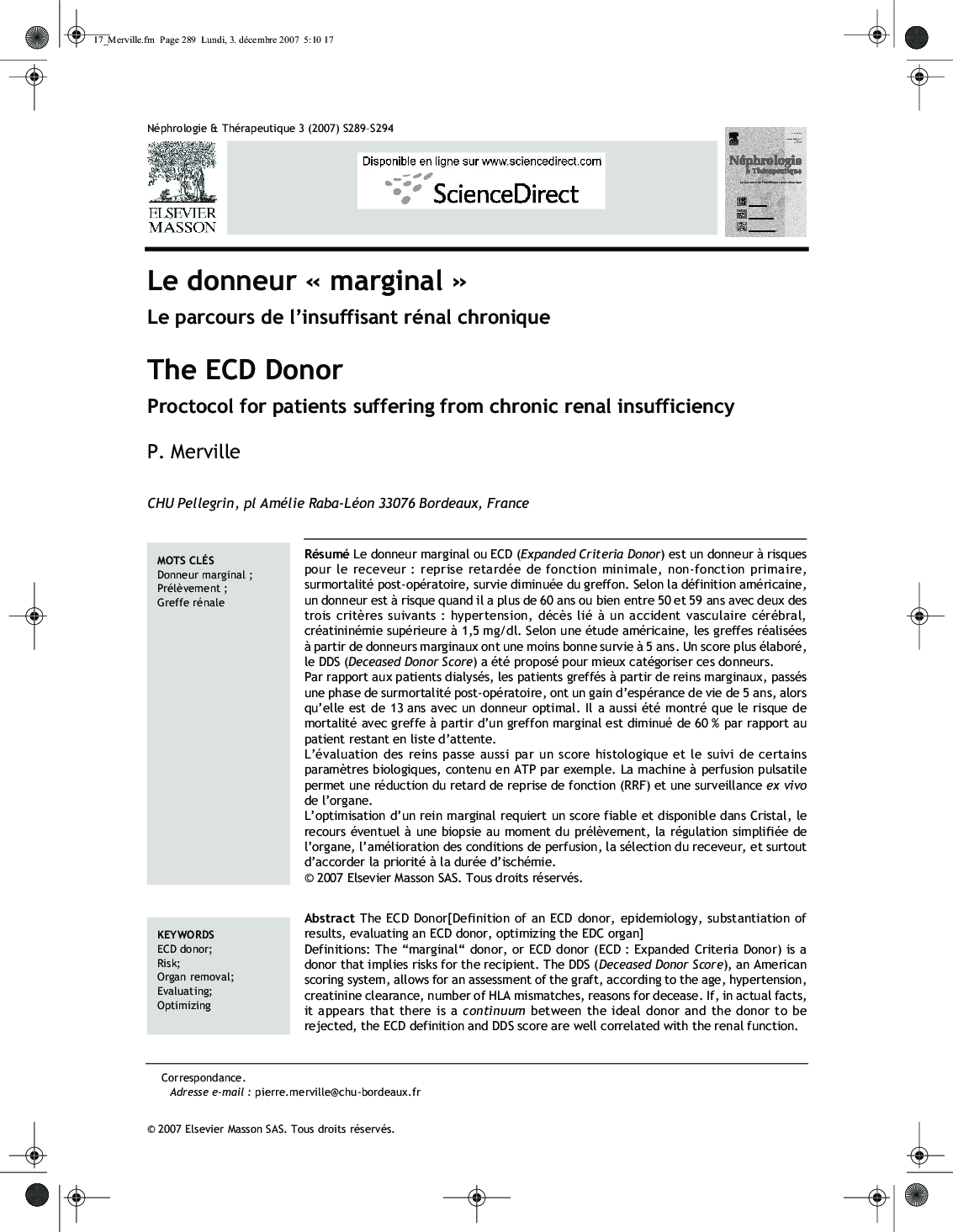| کد مقاله | کد نشریه | سال انتشار | مقاله انگلیسی | نسخه تمام متن |
|---|---|---|---|---|
| 3895691 | 1250177 | 2007 | 6 صفحه PDF | دانلود رایگان |

RésuméLe donneur marginal ou ECD (Expanded Criteria Donor) est un donneur à risques pour le receveur : reprise retardée de fonction minimale, non-fonction primaire, surmortalité post-opératoire, survie diminuée du greffon. Selon la définition américaine, un donneur est à risque quand il a plus de 60 ans ou bien entre 50 et 59 ans avec deux des trois critères suivants : hypertension, décès lié à un accident vasculaire cérébral, créatininémie supérieure à 1,5 mg/dl. Selon une étude américaine, les greffes réalisées à partir de donneurs marginaux ont une moins bonne survie à 5 ans. Un score plus élaboré, le DDS (Deceased Donor Score) a été proposé pour mieux catégoriser ces donneurs.Par rapport aux patients dialysés, les patients greffés à partir de reins marginaux, passés une phase de surmortalité post-opératoire, ont un gain d’espérance de vie de 5 ans, alors qu’elle est de 13 ans avec un donneur optimal. Il a aussi été montré que le risque de mortalité avec greffe à partir d’un greffon marginal est diminué de 60 % par rapport au patient restant en liste d’attente.L’évaluation des reins passe aussi par un score histologique et le suivi de certains paramètres biologiques, contenu en ATP par exemple. La machine à perfusion pulsatile permet une réduction du retard de reprise de fonction (RRF) et une surveillance ex vivo de l’organe.L’optimisation d’un rein marginal requiert un score fiable et disponible dans Cristal, le recours éventuel à une biopsie au moment du prélèvement, la régulation simplifiée de l’organe, l’amélioration des conditions de perfusion, la sélection du receveur, et surtout d’accorder la priorité à la durée d’ischémie.
The ECD Donor[Definition of an ECD donor, epidemiology, substantiation of results, evaluating an ECD donor, optimizing the EDC organ]DefinitionsThe “marginal” donor, or ECD donor (ECD : Expanded Criteria Donor) is a donor that implies risks for the recipient. The DDS (Deceased Donor Score), an American scoring system, allows for an assessment of the graft, according to the age, hypertension, creatinine clearance, number of HLA mismatches, reasons for decease. If, in actual facts, it appears that there is a continuum between the ideal donor and the donor to be rejected, the ECD definition and DDS score are well correlated with the renal function.EpidemiologyThe increase in the age of the average donor (since 2002 some donors over 75 years of age have appeared) and the evolution of the reasons for decease mean that, to date, one patient out of three from whom an organ is removed in France is an ECD donor.SubstantiationThe patients transplanted using marginal kidneys, following a phase of excess post-transplant mortality in relation with the graft, have a life expectancy gain of 5 years as compared to the wait-listed transplant candidates, versus 13 years in the case of an optimal donor.Nonetheless, the mortality risk in the case of ECD transplantation is decreased by 17 % as compared to the standard treatment (wait-listed patients and optimal graft), and 60 % should the patient remain on the waiting list.An algorithm is available so as to adapt and guide the decision-making process depending on the recipient.AssessmentA correct assessment of donor kidneys, beyond the DDS system, also requires using Remuzzi's histological score (on glomerular, tubulointerstitial and vascular compartments), and a follow-up on the decrease of its ATP. Using a pulsatile infusion device makes it possible to reduce the delay in functional resumption, and to monitor the organ ex vivo.OptimizationThis involves having a reliable and available score in “Cristal” ; possible recourse to a biopsy at the time of organ removal ; saving time on the deadlines ; improving the conditions for infusion ; selecting the recipient and adapting his/her immunosuppressive treatment.The key issue in optimizing an ECD/marginal graft is that of reducing the ischemic time to less than 10 hours of ischemia, as marginal donor kidneys can give identical and excellent results on a controlled population.ConclusionStill, it is essential to have a transparent approach towards the patient via, for example, an approved consent process.
Journal: Néphrologie & Thérapeutique - Volume 3, Supplement 4, December 2007, Pages 289-294